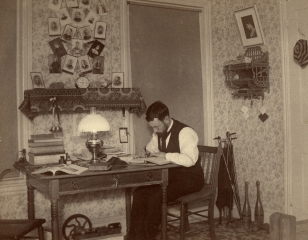boys signed. On another occasion, a student caught in exceptionally incriminating circumstances sought exceptional clemency. Unmoved, he responded, “Young man, sometime you may be President of Madison University, but not now, not now.”
Student town-gown relations were generally good. Hamilton remained unchanged from the pre-1869 years-a country village of about 1,500 inhabitants whose economic base rested primarily on providing goods and services for the adjacent area and for all those connected with the University. It was not until 1870 that a railroad, the Utica, Clinton, and Binghamton, reached the village, giving it access to the New York Central in Utica and the New York Oswego and Midland at Smith’s Valley (Randallsville); the latter provided a connection with the New York Central at Oneida to the north and New York City and intervening points to the south. About three years previous, rail service had become available at Poolville, about four miles southeast of Hamilton, when the Utica Chenango and Susquehanna was put through to open up a line to Binghamton. Townspeople and students alike recognized that the coming of the railroads brought a new era by breaking down the community’s isolation. Timetables were published regularly in the student paper and soon special trains to carry them to athletic contests in Clinton and Utica and to bring in alumni and friends at commencement became customary. The new railroads seem to have stimulated business life; real estate was improved, flagstone sidewalks were laid, and a new brick block built to replace the old stores in the center of the village. The construction of Tripp’s Hall or “opera house” in 1870 encouraged both townspeople and students to import a variety of entertainers, musicians, and lecturers and afforded campus organizations excellent facilities for their public meetings.
From time to time villagers complained of student rowdiness. One source of friction was the delay at the post office each evening as they waited for the mail to be sorted and distributed. Sometimes bored students and “townies”
scuffled and broke window lights. Another irritation was the noise and clangor from “ringing the rust”
each spring. Yet, there were no serious clashes.
Students often participated in political campaigns. Since the Hill was predominantly Republican, as were the villagers, they found a ready welcome at rallies and helped to swell torchlight processions and victory parades. Occasionally those who went to the polls were chal-





